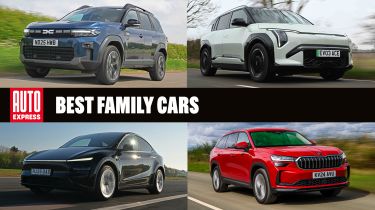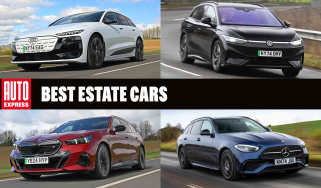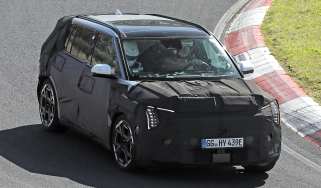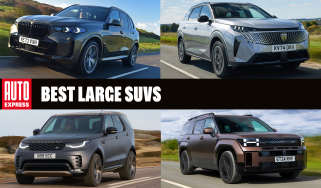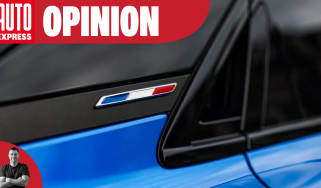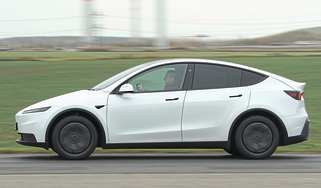Best family cars to buy 2026
Family cars come in a variety of shapes, from hatchback to SUV. But which is best for you?
The best family cars boast a diverse skill set, making them able to cope in the wide variety of different situations that life with children tends to throw up (hopefully not in the literal sense). These cars should be practical, reliable, safe, and solidly built to take all that life can throw at them.
But those are essentials; we also want a family car to look good, have a dash of style, and drive with more than a hint of agility. They should also be comfortable and come with lots of advanced tech to make life on the road with a family easier to manage. Oh, and we also want a selection of different powertrains so we can select what works best for us - petrol, diesel, hybrid, plug-in hybrid or electric.
A tall order? Perhaps, but our road test experts have thoroughly tested every family car on sale in the UK and gathered this list of the top 10 best family cars that deliver across the board.
Top 10 best family cars in the UK
1.Skoda Octavia
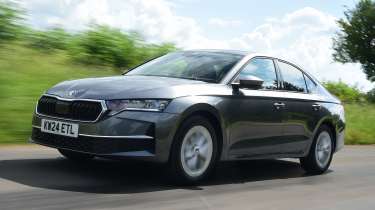
- Prices from £27,400
- Auto Express Family Car of the Year
| Pros |
|
| Cons |
|
‘All-rounder’ is a term coined for the Skoda Octavia. It simply does most things very well, and a few things brilliantly.
As you’d expect, the Skoda Octavia Estate is the most practical option with a stonking 640 litres of boot space, but the hatchback really isn’t far behind with 600 litres. In short, both variants can take on pushchairs, shopping and just about anything else you can throw at them. Passengers have a huge amount of space to enjoy, too, and even our tallest road testers had plenty of room to stretch their legs while sitting in the back seats.
The Octavia is primarily a sensible car rather than a fun one, although there is the option of the sportier vRS version if you desire a bit more power. The standard cars are respectably comfortable and refined, though, and munching up motorway miles is a complete doddle.
No version of the Octavia will be too harsh on the wallet. Opt for a petrol mild-hybrid model, for example, and you'll be able to achieve an average fuel economy figure of over 50mpg without much of a struggle.
This combination of practicality, quality and overall ease of use made the Skoda Octavia an obvious choice for our Family Car of the Year award in both 2024 and 2025, and its keen starting price only sweetens an already excellent deal.
“If you need a hugely practical family car that’s comfortable, refined, good to drive and well-equipped, then the Octavia should be near the top of your shopping list.” - Alex Ingram, chief reviewer.
Skoda Octavia reviewSkoda Octavia deals
2. Skoda Elroq
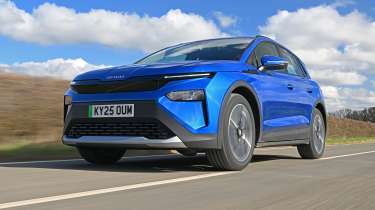
- Prices from £31,500
| Pros |
|
| Cons |
|
The Skoda Elroq is only the brand’s second EV, but it’s also one of the best electric cars you can buy.
Although our 2025 Car of the Year is a bit smaller than its Skoda Enyaq cousin, it’s still a very roomy car with a 470-litre boot as well as a number of useful storage compartments. As always, there are a number of useful ‘Simply Clever’ features, too, including adjustable boot nets, umbrellas, a tyre tread depth gauge and an ice scraper.
In typical Skoda fashion, the Elroq is very drama-free in the way it drives. The fully-electric powertrain means it’s a quiet car for the most part, too, although the door mirrors do cause a fair amount of wind noise at motorway speeds. If you’re driving in the city, the Elroq’s 9.3-metre turning circle makes it a breeze to manoeuvre in narrower streets. The amount of power on offer depends on your chosen variant, but even the base Elroq 50 has more than enough shove for most needs.
While electric cars are now eligible for VED road tax charges, they still offer a considerable amount of savings on running costs compared to combustion-powered cars - especially if you can charge at home. If you’re a company car driver, you can also take advantage of a very low 2 per cent Benefit-in-Kind tax rate.
“The Elroq is so good that we see it creating a bit of a dilemma for Skoda: why would anybody need the larger Enyaq now?” - Ellis Hyde, news reporter.
Skoda Elroq reviewSkoda Elroq deals
3. Skoda Superb
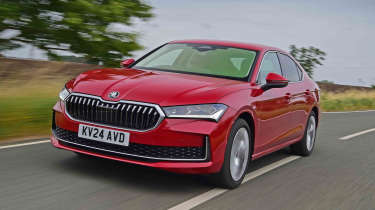
- Prices from £35,700
| Pros |
|
| Cons |
|
Few cars are as boldly named as the Skoda Superb, but this is indeed one our favourite family cars for a variety of reasons.
Whether you choose the Superb in hatch or estate form, they both have generous boots with up to 690 litres on offer when all five seats are in place. The Superb’s cabin also feels well put together with some excellent materials; it withstood our expert road testers’ prodding and poking, so we reckon it’ll stand up well enough to the tests posed by your youngest passengers as well.
Much like the slightly smaller Octavia, the Superb comes with the option of mild-hybrid or diesel power, and both variants can return over 50mpg. The Superb didn’t exactly surprise us with its sporty driving experience on the move, but it is as calm and refined as we’d expect from a much pricier executive car. If you do want to firm things up a little bit, Skoda’s optional ‘Dynamic Chassis Control Plus' pack introduces adaptive dampers, but this will set you back by over £1,200.
While it’s true the Superb is more expensive than ever before, it’s still a car that feels like true value for money. In entry-level SE Technology spec — which starts from around £35,000 — you’ll still get an upmarket cabin that’s adorned with useful tech including a 13-inch touchscreen infotainment system along with Skoda’s clever 'Smart Dials'.
“The Skoda Superb combines everything we loved about its award-winning predecessor with newfound sophistication.” - Ellis Hyde, news reporter
Skoda Superb reviewSkoda Superb deals
4. Dacia Jogger
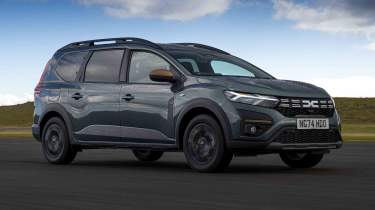
- Prices from £19,000
- Best value for money
| Pros |
|
| Cons |
|
Check out the price of the Dacia Jogger and you may think it lacks quality and equipment, but this is simply not true.
Sure, it’s not as plush as some of the other models in this list, but the Jogger offers van-like capacity for supermini-like money. It’s easily one of the cheapest seven seaters you can buy brand-new today. You can also fold those seats for up to 2,085 litres of cargo space, so it’s an excellent load hauler as well. If you do want to use all seven seats, we recommend reserving the rearmost row for your smallest passengers, as it’s a little tight on leg and headroom.
The Jogger isn’t exactly sporty in its appearance, and it certainly isn’t like this to drive, either. Both the petrol and hybrid models take over 10 seconds to accelerate from 0 to 62mph but, realistically speaking, this probably won’t matter when you’re on the school run. If you’re planning on taking longer trips, we were particularly impressed with how quiet the hybrid car’s engine remains at higher speeds.
The hybrid-powered Jogger also has the edge when it comes to fuel economy, as it’ll achieve up to 58.9mpg on the WLTP combined cycle. The 0.9 TCe petrol engine isn’t alarmingly thirsty, though, as it’ll reach up to 48.7mpg on the official tests. A starting price of less than £19,000 (for the petrol model) is arguably the biggest highlight of them all.
“There’s more to the Dacia Jogger than just passenger carrying, because it’s a practical car that offers versatility and low running costs” - Dean Gibson, senior road test editor.
Dacia Jogger reviewDacia Jogger deals
5. Skoda Kodiaq
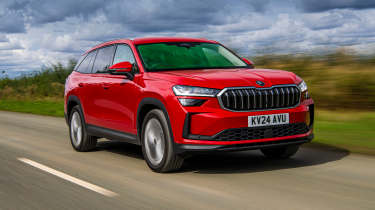
- Prices from £38,100
- Best for larger families
| Pros |
|
| Cons |
|
With oodles of space, ‘simply clever’ kit and general great value for money, the Skoda Kodiaq is a tempting option for larger families.
The number of seven-seaters on the market has waned slightly due to shrinking of the MPV class, but the Kodiaq SUV is one of the most practical seven-seat models out there. As is the case with a number of cars, the rearmost row is best reserved for the smallest passengers.
Alternatively, if you have a five-person family with an unhealthy obsession with luggage. The Kodiaq can take on a whopping 910 litres of cargo with the rear seats folded down. If you need all seven seats, this decreases to a still respectable 340 litres.
There’s quite a bit of choice when it comes to powering the Kodiaq, too, with petrol, diesel and plug-in hybrid power to pick from. We’d opt for the petrol option as it provides enough shove for most needs and can still return north of 45mpg. If you have lots of motorway miles to cover, the diesel is the better pick. It’s also worth noting that the PHEV is only available in five-seat form.
Whichever powerplant you choose, the Kodiaq is a comfortable cruiser for the most part, only falling foul of the very worst of the UK’s Tarmac. The engines pull well without much effort, too, so in-town driving is pretty easy for a car of this size.
You’ll need to stick to the lower end of the trim level spectrum if you want to avoid the luxury car tax, but there’s no cause for alarm as there’s still plenty of useful kit thrown-in with the base SE model. As you probably expected, Skoda’s ‘simply clever’ bits can be found here, including the all-too-important umbrella storage.
“This Skoda is a comfortable cruiser on the motorway, with minimal road and wind noise to be heard. Skoda’s cylinder-deactivation system is imperceptible in its operation – the only clue that it’s working is a small icon that appears within the dials” - Dean Gibson, senior road test editor.
Skoda Kodiaq reviewSkoda Kodiaq deals
6. Citroen C4
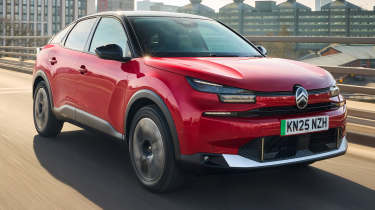
- Prices from £22,600
| Pros |
|
| Cons |
|
A mid-life refresh has brought the Citroen C4 back into the limelight, and while it still isn’t the most groundbreaking family hatch, it is a very affordable one.
While the updated C4 looks a bit different on the outside, it’s on the inside where you’ll find its most impressive attribute - a refreshingly simple cabin with plenty of storage solutions. Moving up the trim levels introduces more useful kit, too, such as a dash-mounted tablet stand or variable height boot floor. No matter which C4 you go for, you’ll have 380 litres of boot space to use, which is just one litre short of a Volkswagen Golf.
Luxurious comfort for supermini money has long been a Citroen party trick, and the C4 continues this trend with ‘hydraulic cushions’ in the suspension that do an excellent job of ironing out bumps in the road. One area where sportiness does get in the way, though, is with visibility, as the C4’s spoiler obscures the view out of the rear windscreen.
C4 buyers have the choice of petrol and hybrid power, as well as the fully-electric Citroen e-C4. As you’d probably expect, the e-C4 is the one to go for if you want the biggest savings on running costs, but it does carry a premium of around £5,000 over the regular C4.
“Citroen’s family hatch is now treading a value-driven path few other manufacturers can seemingly compete with.” - Alastair Crooks, senior news reporter.
Citroen C4 reviewCitroen C4 deals
7. Dacia Bigster
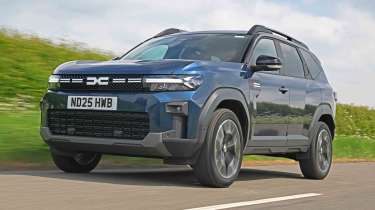
- Prices from £25,200
| Pros |
|
| Cons |
|
The Dacia Bigster takes the good bits of the Duster and puts them in a bigger car, hence the name.
While it’s more expensive than its smaller sibling, the Bigster still carries an appealingly sensible starting price that undercuts several of its mid-size SUV rivals. 612 litres of boot space make it one of the better load-luggers of the class, too, and both front and rear passengers have adequate head and leg room. Our road testers did find the seats to be a tad uncomfortable after covering long distances at the wheel.
Although it’s rugged to look at, the Bigster remains pretty well refined at cruising speeds. Moving at a snail’s pace does cause things to get a little bit bouncy, but this soon fades out when you gain a bit of momentum.
Neither the petrol or hybrid powertrains options can be described as powerhouses, but they make up for this with low running costs. Naturally, the hybrid offers the best fuel efficiency at up to 58mpg on the WLTP combined cycle. The Bigster also comes with the option of four-wheel drive, which helps it live up to its tough appearance.
Unlike some entry-level Dacia models that feel a bit Spartan inside, the Bigster Expression is pretty well equipped with touches like a 10.1-inch touchscreen infotainment system, dual-zone climate control and alloy wheels. We think it’s worth forking out a bit more on the mid-range Journey trim, though, as this brings a lot more kit without annihilating your bank account.
“The ride can be a little fidgety at lower speeds, the cabin is clearly built to a price and the hybrid powertrain is a little noisy in certain situations, but overall the Bigster offers great value for money that means it’s easy to overlook its shortcomings.” - Dean Gibson, senior road test editor.
Dacia Bigster reviewDacia Bigster deals
8. Kia EV3
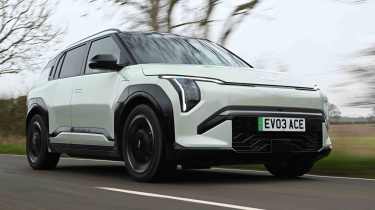
- Prices from £33,000
| Pros |
|
| Cons |
|
The Kia EV3 is one of the brand’s cheapest EVs to date, and it happens to be one of its best, too.
With a design that’s largely inspired by its EV9 big brother, the Kia EV3 is a very distinctive machine to behold, but it also ticks many of the fundamental family car boxes. It’s reasonably spacious for its size, with a decent amount of headroom on offer. The rear seats are best reserved for smaller passengers, though, as the passenger space is slightly sacrificed in favour of boot space (460 litres in total). If you are seating particularly young passengers in the back, the doors open wide so fitting a child seat and hooking it up to the ISOFIX points is a refreshingly straightforward task.
Being an electric car, the EV3’s acceleration is instantaneous which is particularly great for pulling away quickly from tricky junctions. Every EV3 has 201bhp on tap, but it’s better described as potent rather than entertaining. We’re big fans of Kia’s iPedal regenerative braking system, as it is highly adjustable and provides one-pedal driving should you want to use it.
If you have a wallbox charger on your driveway, a full charge should cost around £20, and this is far cheaper than an equivalent fill-up of petrol or diesel. Unfortunately, public chargers can push these costs to some alarming highs, so this particular benefit may be lost if you don’t have access to home charging. Opt for the larger 81.4kWh and the EV3 claims up to 347 miles on the WLTP combined cycle.
“In terms of price and size, the EV3 looks similar to Kia’s Niro EV, but most buyers will find the EV3 the more attractive option in most areas.” - Alex Ingram, chief reviewer.
9. Toyota Corolla Touring Sports
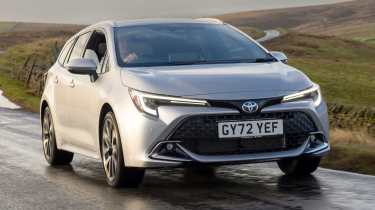
- Prices from £30,800
| Pros |
|
| Cons |
|
While the hatchback is a little bit snug inside, the Toyota Corolla Touring Sports adds estate car practicality to this otherwise great all-rounder.
Although it’s one of the smaller estate cars you can buy, the Corolla Touring Sports still offers a perfectly usable amount of occupant and cargo capacity for family use. Inside there’s plenty of room for adults in the front, but the rear seats are slightly better suited to children as the rakish roof takes its toll. Boot space depends on your chosen powertrain (both of which are full-hybrids) with the 1.8-litre car offering 596 litres and the 2.0-litre dropping slightly to 581 litres.
While you’d be forgiven for thinking the Corolla would be a little uninspiring in the way it drives, you can actually have a bit of fun behind the wheel. Our road testers found the ride quality, handling and steering all offered a better experience than the Volkswagen Golf Estate when the two cars went head-to-head in one of our twin tests. In addition to this, both of the hybrid powertrains offer more than 60mpg on the WLTP combined cycle, which should mean fill-ups are few and far between.
While it's not the last word in luxury, the Corolla does feel good and sturdy to the touch, while a couple of updates during its lifetime have brought the tech more into line with younger rivals. Keep the Corolla maintained at a Toyota-approved workshop and the warranty cover can last up to ten years or 100,000 miles, which even eclipses Kia’s seven-year plan.
“Inside, the Corolla’s modern cabin is clearly laid out and generally feels very well made, with solid build quality and some soft-touch materials scattered about. It’s not luxurious, but the cabin quality certainly eclipses the harsher, plasticky-feeling interior of the current VW Golf. We also like that Toyota has stuck with physical buttons for the climate controls.” - Dean Gibson, senior road test editor.
Toyota Corolla Touring Sports reviewToyota Corolla Touring Sports deals
10. Tesla Model Y
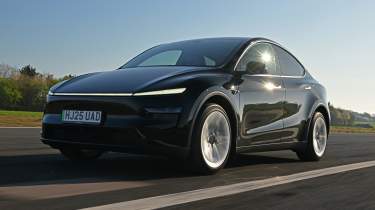
- Prices from £45,000
| Pros |
|
| Cons |
|
Politics and controversies aside, the Tesla Model Y is still a hugely popular electric family car, and for good reason.
Although it’s primarily known for being tech-filled and alarmingly quick, the Model Y still gets the fundamental family car qualities right. There’s over 800 litres of boot space at the back, more storage under the bonnet at the front, and plentiful amounts of head, leg and foot room for all five occupants. Loading a big shop isn’t a nightmare, either, thanks to a low load lip and well thought-out load area design.
There’s more good capacity-related news from the battery department, too, as every model claims over 300 miles on the official WLTP Combined Cycle.
In typical Tesla fashion, there’s plenty of poke underneath the right pedal, too. There’s no dedicated Performance model (yet) but no model takes less than six seconds to blast from 0-60mph. Charging can be equally quick, too, with a peak 250kW capability.
The usual Tesla minimalist theme can be found inside the refreshed Model Y, although the firm has thankfully grown out of its brief ‘no indicator stalk’ phase. We think Tesla’s infotainment system is one of the more intuitive on the current market, and it’s quick and easy to navigate. We do wish that Apple CarPlay and Android Auto would make an appearance, though.
“The Tesla’s regenerative braking is superbly composed. Nothing in this class can bring itself to a halt with the same limo driver-like smoothness as the Y, which makes low-speed manoeuvres very relaxing.” - Alex Ingram, chief reviewer.
Tesla Model Y reviewTesla Model Y deals
How we choose the best family cars
Our road test team have driven every family car on the UK market over thousands of miles on the full range of different roads, and the best family cars listed above are the definitive view on today's top choices.
For our survey data we know what the top concerns are for buyers in this segment and we weigh that criteria accordingly.
- The top concern is reliability with 63.5% of our survey respondents identifying this as one of their main priorities.
- Value for money was chosen by 54%
- 51% identified running costs
- 48% chose comfort
- 42% picked ride and handling
- Design was given less importance than in most other sectors, only being chosen by 27% of our respondents.
Best family car deals
Did you know you can sell your car through Auto Express? We’ll help you get a great price and find a great deal on a new car, too.

